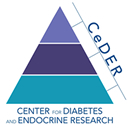Diabetes and Endocrine Research
 Diabetes is a metabolic disease in which body's ability to produce or respond to the
hormone insulin is impaired. In people without diabetes, insulin and glucagon work
together to keep blood glucose levels balanced. In diabetes, the body either doesn't
produce enough insulin or doesn't respond properly to insulin causing an imbalance
between the effects of insulin and glucagon.
Diabetes is a metabolic disease in which body's ability to produce or respond to the
hormone insulin is impaired. In people without diabetes, insulin and glucagon work
together to keep blood glucose levels balanced. In diabetes, the body either doesn't
produce enough insulin or doesn't respond properly to insulin causing an imbalance
between the effects of insulin and glucagon.
In type 1 diabetes, the body isn't able to produce enough insulin and so blood glucose becomes too high unless insulin is injected.
In type 2 diabetes, the body is unable to respond effectively to insulin, which can also result in higher than normal blood glucose levels. Medications for type 2 diabetes include those which help to increase insulin sensitivity, those which stimulate the pancreas to release more insulin and other medications which inhibit the release of glucagon.
The National Diabetes Statistics Report (2017).
- Total: 30.3 million people have diabetes (9.4% of the US population)
- Diagnosed: 23.1 million people
- Undiagnosed: 7.2 million people (23.8% of people with diabetes are undiagnosed)
- Total: 84.1 million adults aged 18 years or older have prediabetes (33.9% of the adult US population)
- 65 years or older: 23.1 million adults aged 65 years or older have prediabetes
Research
Development of Humanized Mouse Model of Type 1 Diabetes.


